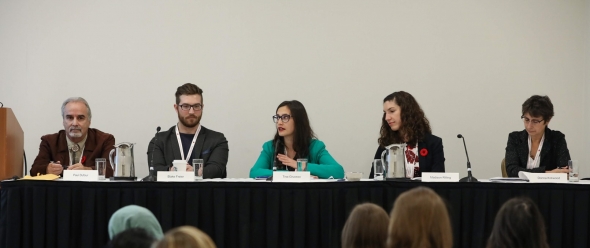Theme 5: Science and The Next Generation
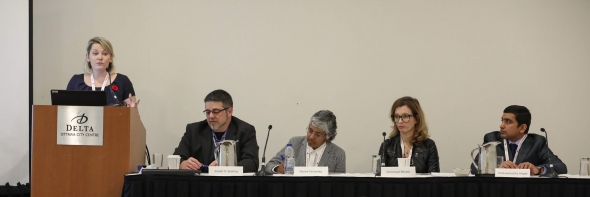
Day 3 – November 9th 2018
Takeaways and recommendations:
Where the rubber meets the road: The real life impact of policy on Canadian postdocs
Organized by: Canadian Association of Postdoctoral Scholars (CAPS)
Speakers: Dominique Bérubé, Vice-President, Research Programs, Social Sciences and Humanities Research Council; Joseph S. Sparling, PhD, Chair, Canadian Association of Postdoctoral Scholars; Krishnamoorthy Hegde, PhD, Postdoctoral Scholar, Institut national de la recherché scientifique and At-Large Member, Canadian Association of Postdoctoral Scholars; Rachel Fernandez, PhD, Associate Dean, Faculty of Graduate and Postdoctoral Studies, University of British Columbia
Moderator: Jenna Haverfield, PhD, Postdoctoral Scholar, McGill University and Vice-Chair Membership, Canadian Association of Postdoctoral Scholars
Takeaways and recommendations
- There is an increased reliance on low-cost labour to drive academic research.
- Postdoc training times are lengthening: up to 8 years and over 20 publications may now be required to become competitive for faculty positions in some fields.
- Less than 20% of current postdocs are likely to attain tenure-track faculty positions in Canada, yet there is often little exposure to non-academic career opportunities.
- The postdoc population is aging. The average age of Canadian postdocs surveyed in 2016 was 34 years. 2/3 of postdocs are married and 1/3 have children.
- Most postdocs make under $45,000 per year.
- All postdocs pay full federal income tax; most also pay full provincial income tax.
- There is no evidence that former postdocs trained in Canada ever surpass or catch up to the average Canadian PhD graduate student who enters the workforce directly.
- The majority of postdocs working in Canada (and particularly those supported by grants/institutional awards rather personal fellowships) are now categorized as employees – largely due to unionization efforts across the country over the past decade.
- There is a wage disparity among postdocs: salaries for doing the same work can vary by >50%.
- Access to paid parental leave for postdocs depends on their source of funding.
- Access to health and dental benefits is highly variable, and depends on employee status.
- Postdocs as employees may lack training opportunities available to non-employee postdocs (i.e., trainees such as fellowship holders).
- On average postdocs work more hours per week than the average Canadian, yet 25% of postdocs do not have access to paid vacation.
- It can be difficult for international postdocs who are not recognized as employees to stay in Canada because their work is not typically recognized as ‘skilled Canadian work experience’.
CAPS recommendations:
- Monitor the postdoctoral training system and track outcomes:
- Postdoctoral data could be collected through the Full-time University and College Academic Staff System (UCASS) run by Statistics Canada.
- U15 institutions could play a bigger role in collecting postdoc data, possibly more detailed than what Statistics Canada would collect, and better for tracking long-term outcomes.
- CAPS has now established a National Registry for all current and former postdocs who trained in Canada, which may provide a wider net for tracking long-term outcomes in the future.
- What gets measured gets acted upon, so together with CAPS National Postdoc Surveys (conducted every 2-3 years) these approaches would help to drive evidence-based improvements in Canadian postdoctoral policy in the future.
- Establish minimum standards of postdoc support:
- Recommended minimum standards should be established at the national level.
- CAPS could play a role in establishing these standards, perhaps in consultation with other stakeholder groups.
- Best if these standards were adopted, endorsed, and recommended by the Tri-Agency and other funding bodies.
- A mechanism for public reporting of institutional postdoctoral policies and working conditions should also be established to promote transparency and adherence to minimum standards, as an incentive for institutions to adopt the recommended standards.
- Classify all postdoctoral scholars working in Canada as employees:
- Unionization of postdocs across Canada has resulted in the majority of postdocs now being classified as employees, with the exception of externally-funded postdocs, such as Tri-Agency fellowship holders.
- CAPS believes that externally-funded postdocs should also be classified as employees given current EI regulations and the nature of postdoctoral work.
- Neither the funding agencies nor the individual institutions have the power to implement such a change, so federal and provincial advocacy will be required to achieve this goal in the future.
- Establish a uniform national policy on postdoctoral training:
- Create an overarching policy for what the training system looks like across the board.
- Who will create the policy, and where will it have teeth?
- The Tri-Agency has limited power to enforce broad policies on our postdoctoral training system since they do not fund most postdocs directly and control of post-secondary institutions fall under provincial control.
- Consider changing the conditions that universities need to meet in order to use grant money to support postdocs.
- The current funding model through the tri-councils means there are more postdocs, but they are generally poorly compensated.
- With respect to most fellowships, the Tri-Agency views their support as partial, not full, salary support, whereas institutions tend to make policies in line with the opposite view.
- With respect to the training ‘pipeline’ – we need a better analogy – one that puts the graduate student at the centre of a hub, with a postdoc as one branch and a variety of other potential careers for PhDs (those that do not require a postdoc) as other branches. In reality, the latter branches are those that most PhDs and postdocs end up following.

Day 3 – November 15th 2019
Takeaways and recommendations:
What Future for Young Science Policy Practitioners?
Organized by: Jean-Christophe Mauduit, University College London
Speakers: Tina Gruosso, President, Québec Science & Policy Exchange; Patricia Gruver-Barr, Research & Innovation Attaché, Québec Government Office in Boston; Donovan Guttieres, Organizing Partner, UN Major Group for Children and Youth; Uzma Urooj, Advisor, Science Strategy, Canadian Institutes of Health Research.
Moderator: Jean-Christophe Mauduit, Lecturer in Science Diplomacy, University College London
Takeaways:
- The world is quickly moving into a knowledge-based economy and global challenges are increasingly science-, technology- and innovation-driven.
- There is an increasing need for science-savvy personnel, from Master’s level to PhDs and early-career researchers, to work in government and international institutions.
- Young scientists are increasingly interested in joining the science and policy/diplomacy interface and can make a significant contribution in helping develop sound policies.
- The increasing supply and demand are creating more and more entry points.
- However, these entry points still remain difficult to find for young scientists who may not yet have engaged in science policy/diplomacy activities which creates an inter-generational barrier to entry (more opportunities for senior scientists).
- In Canada, some entry points are provided by organizations like MITACS (Canada) who place scientists in government through its science policy fellowship and leadership programs. But opportunities also exist at the federal level and regional level (e.g., Fonds de Recherche du Québec “scientists in residence” program).
- Worldwide opportunities include country-specific fellowships (e.g., U.S. AAAS S&T fellows or Mirzayan), university groups and non-profits (e.g. Global Young Academy or Québec Science & Policy Exchange), UN-level groups (UN MGCY Science Policy Interface) or publishing in dedicated journals for young science policy enthusiasts (e.g., the Journal of Science Policy & Governance), etc.
- A PhD is valued but not necessary to work at the science policy/diplomacy interface.
- A broad science-based background gives young people the ability to move from field to field in policy development.
- The private sector is also a significant stakeholder in science and innovation, as it has a great capacity for young scientists and allows them to see policy issues from a different perspective.
- Young people are good at experimenting and adapting. The fact that they are not attached to the old way of doing things can be an advantage. Barriers to entry such as the intergenerational gap and gender issues are slowly diminishing.
Actions:
- Millennials should not be afraid to leverage their strengths, skills and personality in contributing to science policy but need to be proactive in finding activities and pathways to these careers.
- Those who want to become involved in science policy should participate in diverse experiences (e.g., extracurricular activities, building relationships through volunteering and creating their own opportunities through networking).
- Policymaking involves consensus building. Young science policy practitioners can develop these skills by joining forces with others (e.g., likeminded NGOs) to cooperate on funding proposals, rather than competing against each other.
- There is a need to create more initiatives and institutional spaces where young people can engage side-by-side with government and bring new perspectives to international science policy discussions to further bridge the intergenerational gap.
- Universities need develop Master’s level science policy and science diplomacy programs (e.g., University College London MPA in Science, Engineering and Public Policy) to build the science policy/diplomacy interface early-on.
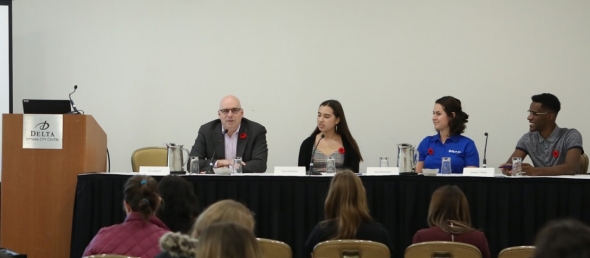
Day 2 – November 8th 2018
Takeaways and recommendations:
Science and inclusivity: going beyond the slogans
Organized by: Deborah Currie, Director, SHAD Fellow Network
Speakers: Alex Bouchard, Inaugural Member of the Prime Minister’s Youth Council and SHAD Fellow 2009; Eva Greyeyes, SHAD Fellow 2018; Joseph Tafese, SHAD Fellow 2017, Student, University of Waterloo
Moderator: Tim Jackson, President and Chief Executive Officer, SHAD
Takeaways and recommendations
- There is a separation of northern communities from mainstream Canadian dialogue. Consider the North and understand how to reach these communities.
- Showcase opportunities to youth from diverse backgrounds. For example, a special preparatory school was advertised only in suburban Edmonton, excluding other communities in the city.
- The conversation around indigenous issues mostly focuses on crises, as opposed to successes.
- Enhance education around indigenous issues in positive ways that deepen appreciation and respect, and understand indigenous thought and education.
- The STEM conversation needs to evolve to shift towards outcomes and inclusion.
- Diverse opinions and approaches lead to workable solutions. Philanthropic pursuits or charities discuss opportunities and potential decisions with their target audience.
- Build approaches with targeted communities that focus on long-term solutions and not short-term wins.
- Effectively communicate that opportunities can be designed to enable these communities.
- Science needs diversity to thrive. Present unique ways of thinking and expanding new pathways.
- Inclusion means redefining progress and identifying new goals that are informed by more than one pathway.
- Integrating traditional knowledge means focusing on the process as well as outcomes.
- Inspire people by demonstrating the promise of projects.
- Establish direct and active outreach to promote inclusion.
- Diversity is a statistic, but you need to feel inclusion.
- Geographical inclusion is essential in Canada.
- Inclusion depends on accessible access and financial support. More Canadians need to travel north to understand the connection to the land.
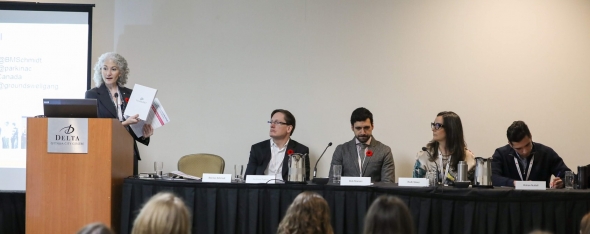
Day 2 – November 8th 2018
Takeaways and recommendations:
Canada 2067 – Lessons learned in building a national vision for STEM education
Organized by: Let’s Talk Science, Bonnie Schmidt
Speakers: Rob Mariani, Senior Vice President, GM Ottawa, Hill + Knowlton Strategies Canada; Rohan Nuttall, Research Assistant at the Urban Predictive Analytics Lab, University of British Columbia; Andrew Parkin, Director, Mowat Centre; Ruth Silver, Founder, Groundswell Projects
Moderator: Bonnie Schmidt, Founder and President, Let’s Talk Science
Takeaways and recommendations
- Canada’s complex education ecosystem demands creative solutions to catalyze large-scale change that can benefit all students. Canada 2067 responded to this challenge with:
- five summits with high school students
- seven Global Shapers’ roundtables with young adults
- a national leadership conference that included federal and provincial governments and diverse stakeholders, and
- a social media campaign that resulted in input from hundreds of thousands of Canadians
Understanding the inclusive survey process
- When designing a system for a specific community (e.g., youth), design it with them, not for them.
- The Canada 2067 survey was designed to be an inclusive, engaging and educational process for survey takers.
- Canada 2067 first used a focus group to ask students, “If you could design your education experience what would that look like?” This tactic failed to produce results, so a full day of engagement with speakers and presentations was held, which led to students being asked a new question: how would they design a school on Mars? This new approach encouraged greater engagement and creativity.
There are similar STEM challenges everywhere
- The challenges Canada faces regarding STEM education are strikingly similar to those being faced around the world.
- Despite all the conversations about this issue, the challenge still remains.
Some key survey findings
- For youth, the school experience can be unnatural and irrelevant; they see it as having nothing to do with real life.
- Teachers are open to change but they need more professional development and resources that will help them enact important changes (e.g., incorporating Indigenous knowledges or new technologies into their classrooms).
- Parents, overall, are optimistic about the education system. However, they believe children need to get more out of school than they are currently.
- Generally, there is strong support for redefining education to be issues-based, student-centered and competency-based.
- Stakeholders support a new vision for education that emphasizes critical thinking over rote learning and a multidisciplinary approach over traditional siloed subjects.
Helping schools build a better STEM experience
- Although most people involved in the survey– students, thought leaders, teachers, etc. – seem to know what needs to be changed, the system hasn’t yet moved for a number of reasons, including:
- People tend to focus on short-term challenges with little time to talk about longer-term goals.
- There are few champions in the school system working on these longer-term issues (e.g., technology change, building relationships with community groups and industry, multidisciplinary approaches). There needs to be more people talking about these issues and more support for those who are.
- Schools should encourage and facilitate more inter-educator networking so people can share ideas and resources.
What else can be done?
- STEM conversations tend to focus on promoting the best and brightest students, which can be counterproductive and reinforce existing hierarchies.
- Instead, the conversation should be culturally positioned to be about everyone. Talk about how all people need to be scientifically literate, good critical thinkers and effective problem solvers.
- STEM education initiatives like Let’s Talk Science should review their programs and operations from the lens of the survey results and recommendations.
- Any decision-making about education should actively involve youth.
- Postsecondary school entry requirements should recognize students who have engaged in innovative approaches to learning.
What’s next for the Canada 2067 report?
- The survey results and recommendations are being disseminated to a wide audience, including policymakers and other decision makers.
- The team is working to ensure that any changes that happen as a result of the report, (e.g., leadership conference being planned by teachers that lines up with the Canada 2067 goals) are recognized and celebrated.
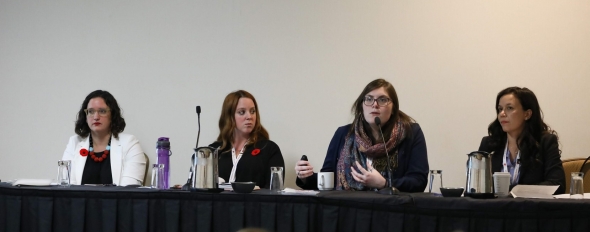
Day 2 – November 8th 2018
Takeaways and recommendations:
Fueling Water Innovation in Atlantic Canada
Organized by: WWF-Canada
Speakers: Angela Douglas, Project Manager, PEI Watershed Alliance/Hillsborough River Association; Carolyn Dubois, Director of the Water Program, The Gordon Foundation; Emma Wattie, Director, Atlantic Water Network, Saint Mary’s University
Moderator: Elizabeth Hendriks, Vice President, Fresh Water Program, WWF Canada
Takeaways and recommendations
- Canada has 20% of the world’s freshwater. Canadians rank water as the country’s most important natural resource.
- People care about what’s happening in their backyard. Citizen scientists are motivated to collect water data in their area.
- Sometimes the data about water are there, but it’s a challenge to access.
A case study: the PEI Watershed Alliance
- Prince Edward Island has a government watershed management fund, which supports 23 community watershed groups that cover almost all of the province’s geography in the PEI Watershed Alliance.
- Water issues are known, but how can they be monitored?
- Governments are approaching the Watershed Alliance, then partnering and sharing data.
- PEI Watershed Alliance has started a partnership with Fisheries and Oceans Canada to monitor the Northumberland Strait, using eel grass as an indicator of ecosystem health.
- Small groups can have an influence on policy.
The Atlantic Water Network:
- The Atlantic Water Network consists of approximately 80 active monitoring groups, many of which are 20-30 years old.
- These non-governmental organizations have been able to leverage their funds 12 times more than government investments.
- These NGOs upload and share data through the Atlantic DataStream, established using an Environment and Climate Change Canada grant. 23 groups are online, and are working to digitize their data.
Sharing and managing water data:
- People want to play an active role in protecting freshwater. What state are our watersheds in?
- There is a lack of water data sharing infrastructure.
- The DataStream application supports those looking to analyze and upload data. It is an open access tool with a clear approach to data ownership and licensing, a scientifically robust foundation, and has a user-friendly upload/search/visualization interface.
Day 2 – November 8th 2018
Takeaways and recommendations:
Supporting the next generation of northern scientists
Organized by: Polar Knowledge Canada, Jennifer Sokol
Speakers: Joanna Laskey, Director, Pilimmaksaivik (Federal Centre of Excellence, Inuit Employment in Nunavut); David Silas, First Nations Engagement Advisor, Yukon College; Kelsey Wrightson, Director of Policy and Programming, Dechinta Centre for Research and Learning; Krista Zawadski, Curator of Inuit Art, Department of Culture and Heritage, Government of Nunavut
Moderator: Jennifer Sokol, Senior Policy Advisor, Polar Knowledge Canada
Takeaways and recommendations
- Too often, northerners who participate in Arctic science are not recognized as knowledge holders and researchers themselves.
- Despite a renewed focus on Indigenous knowledge systems, few Indigenous researchers are being acknowledged and accredited for their contributions.
Solving northern problems with northern expertise
- Any work being done in Indigenous communities (e.g., research, developing a new initiative, building a new facility) must be done in a co-creative, co-developed and collaborative way that starts from the local knowledges, worldviews and ethical approaches.
- The work must reflect and respect a land-based context for research, teaching and learning.
- Engage elders, youth and community members as equal partners at the frontend of the research: from what questions are being asked and to how the research is conducted, to who retains that knowledge and how it will be used.
- When elders are recognized as knowledge holders and equal collaborators, it demonstrates the value of Indigenous knowledge and the importance of engaging with intellectual traditions that are specific to, and rooted in, that particular place.
- Researchers should engage northern communities with curiosity. Don’t be afraid to be vulnerable and open to challenging your beliefs. Try to make a genuine connection with people in the community.
Northern students face unique barriers
- Most students have to move away from home to pursue postsecondary education. Universities, in particular, are even further south.
- Attending school in the south is often the first time many northern students travel outside their territory. It means adjusting to being way from home and to a different way of living. Travelling home for visits can be too expensive for many students, which contributes to social and cultural isolation.
- For students that have children, uprooting their family to move south for school can be expensive and difficult. They would also need childcare and other supports like while attending school.
- The quality of education in Nunavut can be a barrier.
- Some students struggle to see how school is applicable to the real world, which can be a barrier to finishing or continuing their education.
- The impacts of colonization and historical trauma can be barriers to pursuing careers in science.
Nurturing curiosity at a young age
- More tools and support systems are needed to encourage northern youth to consider careers in science. Various documents recommend how this can be done, including:
- The 1996 Royal Commission of Aboriginal People on the importance of supporting Indigenous language training and education
- Article 13.1 of UN Declaration on the Rights of Indigenous People re: Indigenous communities being able to share philosophies and worldviews for next generations
- Call to Action #65 of the Truth and Reconciliation Commission supporting research projects that will develop a better understanding of reconciliation
- All coursework should bring in elders as respected knowledge holders to create a multi-generational community of learning.
- Listen to the community and learn what is applicable to them.
- All subjects, particularly math, must be connected to the land and start with traditional ways of knowing that integrate western science and epistemologies.
- Local languages should be incorporated into all education.
- Blackboards and desks don’t work. STEM education should incorporate visual, hands-on learning and relate to issues that affect the everyday lives of students.
Successful models
- Nunavut Sivuniksavut is an Ottawa-based college program that services Inuit youth from across Canada’s north. The program focusing on Inuit history and culture, and preparing students for educational, training and career opportunities. Two-third of graduates go onto a post-secondary education.
- Nunavut Arctic College’s Environmental Technology Program incorporates classroom, lab and field experience, and ensures taught skills are practical and fit student needs for everyday life (e.g., small engine repair).
- Both programs work to ensure that students acquire the skills they need to get jobs in Nunavut. The programs also offer support systems for student families such as daycares.
Building research capacity in the north
- Yukon College’s transition to a university will provide students with a more local option for post-secondary education.
- Inuit languages should be used in research workplaces (e.g., in government scientist positions).
- Research organizations and governments working in the north should partner with local communities, value local knowledges, and take a creative approach to hiring processes that is grounded in local realities.
Day 2 – November 8th 2018
Takeaways and recommendations:
Governance of research: how can next generation scientists get involved?
Organized by: Fonds de recherche du Québec, Madison Rilling (Student advisor to Québec’s Chief Scientist)
Speakers: Blake Freier, PhD Student, University of Waterloo; Tina Gruosso, Postdoctoral Fellow, Goodman Cancer Research Center, McGill University; Dr. Donna Kirkwood, Chief Scientist, Natural Resources Canada; Madison Rilling, PhD Student, Université Laval
Moderator: Paul Dufour, Fellow and Adjunct Professor, Institute for Science, Society and Policy in the University of Ottawa
Takeaways and recommendations
Involving the next generation in policy decisions
- Involve student researchers and postdocs in decision-making and institutional governance to ensure their needs and values are reflected in any decisions that are made.
- How society conceptualizes science is changing. Future researchers understand this change and are often the ones leading it.
- Next generation scientists need to have active and respected seats at the policymaking table.
- Student researchers and postdocs bring unique perspectives that are relevant to their generation.
- Next generation scientists are the leaders and decision makers of tomorrow.
Making science policy accessible to all students
- Many students are not aware that science policy exists.
- Academic institutions should be more involved in raising awareness, by creating programs/initiatives or better promoting ones that already exist.
- Institutions that do have programs are not as well connected to each other as they used to be, and they need to be encouraged to re-forge those connections.
- We need a broader definition of research excellence that includes supervisors exposing their graduate and post-doc students to career potentials other than academia.
- Champions for policy learning and student integration into policy processes are essential.
- Unfortunately science policy is still relatively elitist – there are only a few positions on boards, only a few fellowships, etc. and the space is not accessible for some underrepresented groups. This needs to change.
- It is difficult for students to get involved in science policy as the opportunities are clustered around only a few academic institutions.
- There is a need for a cross-Canadian network to support and offer resources to interested students outside these institutions.
- Such initiatives can empower people to start their own organizations. Science & Policy Exchange is an excellent student-driven model for such organizations.
- They are also important for sustainability – there is a high turnover in student populations so Canada needs a stable source of support for any existing programs.
A nation-wide portal/platform would boost the science policy ecosystem
- Such a platform would allow students to exchange ideas and best practices.
- It could serve to share relevant upcoming events and involvement opportunities.
- Students facing institutional or structural barriers could go to the portal for advice and support.
- It would help different groups connect, coordinate efforts and understand each other’s role. This connection could avoid repetition of efforts while allowing groups to access each other’s strengths and networks.
- Dually acting as a network, such a platform could serve public, private and governmental organizations for more easily finding and involving next generation scientists in their governance and decision-making structures.
Giving students a voice in government
- There are good examples of existing programs that bring the student voice to government, but there is a need for them to be advertised, celebrated and replicated widely.
- Students benefit by broadening their horizons, learning about policy and getting practical experience, and the government profits from the influx of fresh ideas and the perspective of the next generation.
- The growing network of departmental science advisors can help support more training around science policy, and advocate for more programs that give students exposure to policy experience.
- The national Mitacs Canadian Science Policy Fellowship has been so successful that British Columbia recently implemented a similar program. Other provinces are looking at following suit.
- Science Outside the Lab North (SOtLN) aims to provide immersion training to students related to issues that affect science, politics and society.
- Natural Resources Canada (NRCan), and other federal departments, use the Policy Analyst Recruitment and Development Program to recruit Master’s and Ph.D. graduates to work on different files, with a commitment to hire them at the end if they are successful.
The example of the Comité intersectoriel étudiant
- The Comité intersectoriel étudiant (CIÉ) of the Fonds de recherche du Québec (FRQ) advises Québec’s Chief Scientist and is mandated to identify strategies to promote access to funding for graduate studies, foster excellence of student research, and contribute to the local and international promotion of research stemming from Québec.
- Some reasons why the model is successful:
- Named by the Québec government, three members of the CIÉ sit as full directors on each of the provincial granting agencies board (i.e., 1 per board: health sciences, natural sciences & technology, and social sciences & humanities). This gives a strong voice and presence to students and postdocs within the granting agencies.
- Since 2014, the CIÉ has worked to integrate student researchers within the FRQ’s governance structure, namely on program and ethics committees.
- The CIÉ recently became a statutory committee and is now anchored into the FRQ’s governance structure (i.e., the CIÉ is no longer dependent on the acting Chief Scientist).
- The committee is intersectional; it is the only statutory committee that spans across Québec’s three Research Funds.
- The committee was given time and space, as well as support and resources, by the FRQ to mature and forge its own path within the granting agencies.
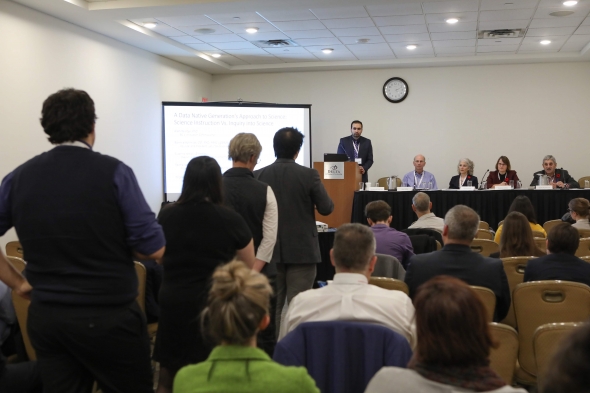
Day 1 – November 7th 2018
Takeaways and recommendations:
A Data Native Generation’s Approach to Science: Science Instruction vs. Inquiry into Science
Organized by: STEM Fellowship, Mohammad Asadi Lari
Speakers: Suzanne Kettley, Executive Director, Canadian Science Publishing; Sacha Noukhovitch, Founder and Executive Director, STEM Fellowship; Bonnie Schmidt, Founder and President, Let’s Talk Science; Alan Winter, British Columbia’s Innovation Commissioner
Moderator: Mohammad Asadi Lari (), Managing Director, STEM Fellowship & MD/PhD Candidate, U of T
Takeaways and recommendations
- “Data natives”, individuals who have grown up with ready access to digital technologies, acquire information differently than did their predecessors who had less or no access to these innovations. This distinction is especially true in education, which includes everything from formal classroom activities to on-the-job training. Organizations engaged in any kind of educational initiative must consider how to deal with this new generation.
- Governments at all levels have become interested in how scientific and technical talent is being developed, since talent has become a key resource that attracts desirable high-tech employers to specific jurisdictions.
- Canadians are eager to discuss the future of STEM education, as members of Let’s Talk Science discovered when they launched a national dialogue on the subject called Canada 2067.
- Scientific publishers are confronting the changing information needs of data natives, such as a growing emphasis on open access models.
Digital content
- It is not enough to digitize existing curricula; the curriculum and teachable subjects must be redefined to reflect new economic, technological and cultural realities.
- Computer coding isn’t the main skill data natives need. Students need to be taught higher level reasoning and critical thinking with Big Data.
- Canadian educators have benefited from Canada’s robust natural resource economy, which makes the country rich enough to acquire digital technologies and the expertise to manage them. In places that cannot afford to do so, educational systems have been radically redesigned to ensure that technological innovation takes place at the domestic level, a goal that means fostering the necessary talent to do so.
In the classroom
- Educators who have incorporated digital technology in their classrooms have found that consumers and producers of such technology have differing perceptions of its value and application. These groups need to be brought together as such products are being designed so that the result reflects a shared vision of its purpose.
- Although data natives are presumed to be literate and comfortable with digital technologies, students expressed a need for technical training that would ensure they reap the educational benefits of these innovations.
- Student-driven learning, centred on particular projects or inquiries defined by students, can be highly rewarding and inspirational for participants. This approach is also effective outside of traditional classroom settings, such as when industrial users need to learn how to apply new technologies in their work.
Future of educational institutions
- Digital teaching methods may not reach all students in Canada to the same extent or in the same way. This is an unavoidable fact of national life, given that education comes under provincial authority with standards that can vary across the country.
- The actions and demands of data natives might be expected to shape the way education is conducted, but many of their aspirations have not changed, such as earning credentials to gain access to medical school.
- Teachers who are trying to reach data natives must themselves be steeped in the same digital technologies as their students, sharing a similar knowledge and comfort level with how these systems work.
- Data native students are not looking to teachers to provide specific educational solutions. Rather, students want tools that enable them to define and solve educational problems for themselves – skills that will benefit them throughout their lives.
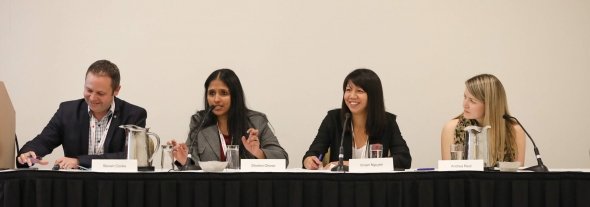
Day 2 – November 8th 2018
Takeaways and recommendations:
Enabling interdisciplinary for the next generation of problem solvers
Organized by: College of New Scholars, Artists and Scientists of the Royal Society of Canada, Steven Cooke
Speakers: Dr. Shohini Ghose, Professor, Physics and Computer Science; Director, Centre for Women in Science (WinS); Vice-President Elect, Canadian Association of Physicists; Dr. Vivian Nguyen, 2017-18 Mitacs Canadian Science Policy Fellow, Office of the Chief Scientist at Natural Resources Canada; Andrea Reid, PhD Candidate, University of British Columbia and Carleton University
Moderator: Steven Cooke, Canada Research Chair and Professor, Institute of Environmental and Interdisciplinary Sciences at Carleton University
Takeaways and recommendations
- Interdisciplinary, which cuts across the disciplines, must include participation from social scientists.
- Effective interdisciplinarity requires that you explore new methods, be humble and be open to learning new things.
- To promote inclusion, introduce collaborative projects in STEM and focus on team dynamics and working with others.
- Focus on how other disciplines can inform your project, and broaden your perspectives and learning theories.
- Government needs to be more science savvy and academia needs to better understand policy development.
- To deal with complex problems we need “interdisciplinarians” who can draw from many expert disciplines.
- Work to understand the barriers to interdisciplinary work and how to overcome them.
- Screening questions can sometimes be barriers to hiring interdisciplinary experts.
- The current grants programs are specific and don’t promote interdisciplinary work and most scientific publications are discipline specific. We need to create a system that promotes inclusion of different disciplines.
- Institutions are labelling and streaming students too early.
- Emphasize more indigenous education in STEM.
- Make interdisciplinary normal and integrated.
- Expand your network and experiences for new ideas.
- Integrate art into STEM and embrace failures.
- Go to seminars outside your department and expose yourself to other disciplines.
- Explain your work to others and think about what interests them.
- Demonstrate the value of interdisciplinary work.
- Have a mentor outside your department and have students work in other departments.
- Value activities outside of scientific publishing. There are opportunities to inform the government on issues of concern. Become a trusted advisor who can be called upon to provide advice on current issues.
- Learn how to handle science policy when it becomes a political issue. Challenges remain when you want to set an agenda.
- Respond to requests promptly and remain relevant. Respond to what they want not your own agenda. Work to co-design an agenda.
- Bring credibility, independence and good communications to advance your influence. Do not receive funds from political parties and ensure you have a clean reputation.
- Scientists are more likely to promote change if you provide examples of what has worked. Pilot projects are great ways to demonstrate potential.
- Write opinion pieces in newspapers to influence public opinion.

